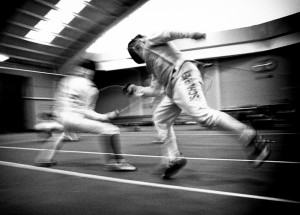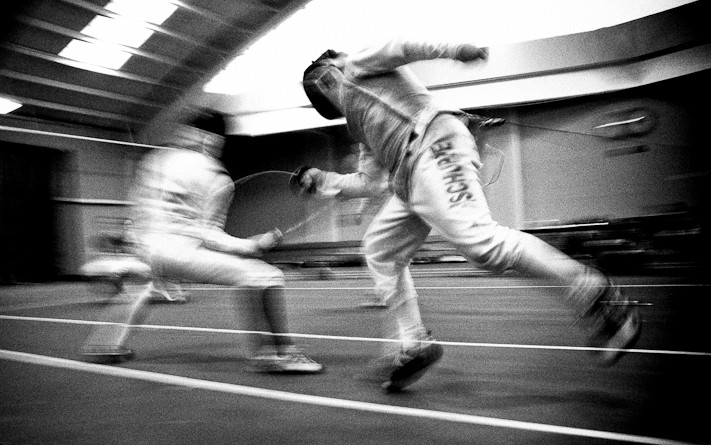A Sworded Affair
A Growing Number of Vermonters are Falling for Fencing
En garde!
 It’s all over in a matter of minutes, but those minutes can be intense. Two fencers, padded and masked, face off with swords, in a sport that requires quick feet and quicker thinking.
It’s all over in a matter of minutes, but those minutes can be intense. Two fencers, padded and masked, face off with swords, in a sport that requires quick feet and quicker thinking.
“Fencing is all about strong legs,” says Dale Rodgers, owner and operator of Westford Sports Center in Westford. “Fencing is a skillful sport, but it also involves fitness.”
Unbeknownst to most Vermonters, there is a vibrant fencing community here in our state. The Green Mountain Division of the U.S. Fencing Association has six clubs that compete locally as well as outside of the state.
The largest of the clubs, the Vermont Fencing Alliance, has 70 members based in two locations: Middlebury and Charlotte. Founded in Middlebury in 1992 by Viveka Fox, it became so popular, the club added the second location five years later.
Fencers compete from September to Memorial Day. Although many competitions are relatively close by, Fox recently took some of her charges to Texas for the National Junior Olympics.
Fox got her start fencing when she was 12 years old and continued fencing through college, earning a North Atlantic Foil Championship along the way. At 5 feet, 2 inches and 125 pounds, Fox likes the fact that brute force is not a necessity for a good fencer, but technique and strategic thinking are. She says a good analogy is boxing, given that the sport involves sudden bursts of energy.
Ray Schuppe, one of the assistant coaches at the Charlotte site, agrees, saying that fencing has been compared to a physical game of chess. That’s true, but the attire is slightly different: fencers wear a considerable amount of padding. The sport is a safe one, but also a very warm one.
“If you’re not sweating,” says Schuppe, “you’re not really fencing.”
Schuppe says those new to watching the sport may not think fencing is much of a workout, but, “Sometimes it’s so intense that you’re barely hanging on.”
Rodgers, who founded the Westford Sports Center in 1996, is a former Olympic pentathlete (fencing, marksmanship, swimming, running, and horseback riding). He has coached a number of sports, including cross-country skiing and biathlon, but fencing is fast becoming one of his more popular programs.
Rodgers attributes this to the fact that fencing is a social sport, but doesn’t discount the effect that movies like the “Pirates of the Caribbean” series may add to the appeal for children. He believes adults like the fact that it is a “lifetime sport,” with the potential for constant skill development.
Rodgers says it is very unusual for one state to have its own division; usually several have to band together. Vermont’s growing interest in fencing is music to Rodgers’ ears, however, because he has a passion for introducing kids to fitness, and fencing is welcoming to children.
“My biggest goal is to keep kids active,” he says, “and fencing really fits that niche.”
Rodgers likes to have kids start as early as 6, using plastic swords and eventually graduating to the real thing.
When it comes to the upper end of the spectrum, there may be no boundaries. While most sports begin their master’s division at age 35, fencers don’t achieve veteran status until they are 50. One of the regular students in the Vermont Fencing Alliance is over 70.
It’s an excellent sport for any age, because of the mental and physical components. As Vermont Fencing Alliance’s Fox puts it: “I love it, because it’s challenging to both the mind and the body. It’s psychological and physical.”
Sidebar
Fencers use three distinct types of weapons: the foil, the epee, and the saber.
- FOIL: Viveka Fox, founder of Vermont Fencing Alliance, starts her students out on the foil because it is light and points can only be scored by hitting an opponent’s torso with the tip of the weapon.
- EPEE: Slightly heavier with points awarded for hits over the entirety of an opponent’s body.
- SABER: Fencing with a saber is faster paced, and it is the only discipline where points are awarded for contact with the side of the blade, as well as the point.
Phyl Newbeck lives in Jericho with her partner Bryan and two cats. She is a skier, skater, cyclist, kayaker, and lover of virtually any sport that does not involve motors, but she has yet to try fencing. She is the author of “Virginia Hasn’t Always Been for Lovers: Interracial Marriage Bans and the Case of Richard and Mildred Loving.”



